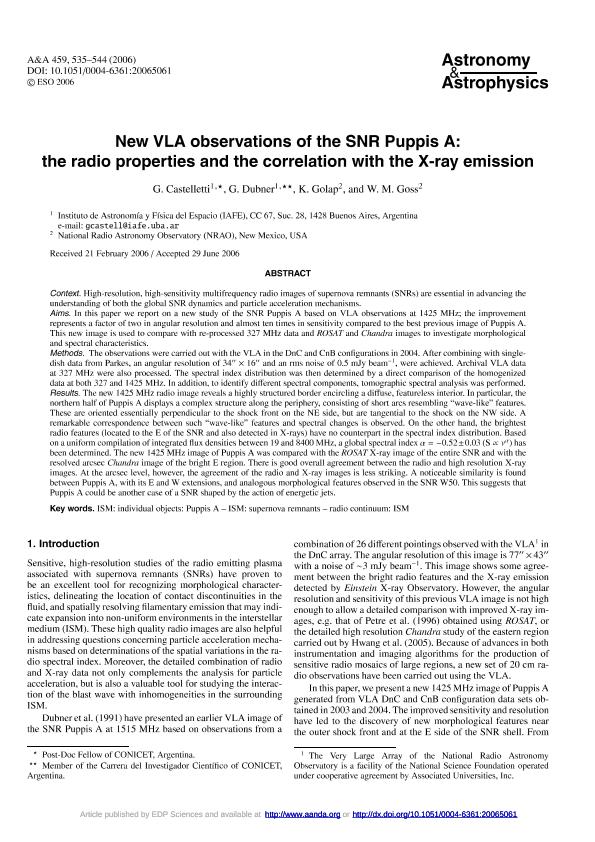Mostrar el registro sencillo del ítem
dc.contributor.author
Castelletti, Gabriela Marta

dc.contributor.author
Dubner, Gloria Mabel

dc.contributor.author
Golap, K.
dc.contributor.author
Goss, W. M.
dc.date.available
2017-08-11T15:35:52Z
dc.date.issued
2006-12
dc.identifier.citation
Castelletti, Gabriela Marta; Dubner, Gloria Mabel; Golap, K.; Goss, W. M.; New VLA observations of the SNR Puppis A : the radio properties and the correlation with the X-ray emission; EDP Sciences; Astronomy and Astrophysics; 459; 2; 12-2006; 535-544
dc.identifier.issn
0004-6361
dc.identifier.uri
http://hdl.handle.net/11336/22173
dc.description.abstract
Context. High-resolution, high-sensitivity multifrequency radio images of supernova remnants (SNRs) are essential in advancing the understanding of both the global SNR dynamics and particle acceleration mechanisms. Aims. In this paper we report on a new study of the SNR Puppis A based on VLA observations at 1425 MHz; the improvement represents a factor of two in angular resolution and almost ten times in sensitivity compared to the best previous image of Puppis A. This new image is used to compare with re-processed 327 MHz data and ROSAT and Chandra images to investigate morphological and spectral characteristics. Methods. The observations were carried out with the VLA in the DnC and CnB configurations in 2004. After combining with singledish data from Parkes, an angular resolution of 34 × 16 and an rms noise of 0.5 mJy beam−1, were achieved. Archival VLA data at 327 MHz were also processed. The spectral index distribution was then determined by a direct comparison of the homogenized data at both 327 and 1425 MHz. In addition, to identify different spectral components, tomographic spectral analysis was performed. Results. The new 1425 MHz radio image reveals a highly structured border encircling a diffuse, featureless interior. In particular, the northern half of Puppis A displays a complex structure along the periphery, consisting of short arcs resembling “wave-like” features. These are oriented essentially perpendicular to the shock front on the NE side, but are tangential to the shock on the NW side. A remarkable correspondence between such “wave-like” features and spectral changes is observed. On the other hand, the brightest radio features (located to the E of the SNR and also detected in X-rays) have no counterpart in the spectral index distribution. Based on a uniform compilation of integrated flux densities between 19 and 8400 MHz, a global spectral index α = −0.52±0.03 (S ∝ να) has
been determined. The new 1425 MHz image of Puppis A was compared with the ROSAT X-ray image of the entire SNR and with the resolved arcsec Chandra image of the bright E region. There is good overall agreement between the radio and high resolution X-ray images. At the arcsec level, however, the agreement of the radio and X-ray images is less striking. A noticeable similarity is found between Puppis A, with its E and W extensions, and analogous morphological features observed in the SNR W50. This suggests that Puppis A could be another case of a SNR shaped by the action of energetic jets.
dc.format
application/pdf
dc.language.iso
eng
dc.publisher
EDP Sciences

dc.rights
info:eu-repo/semantics/openAccess
dc.rights.uri
https://creativecommons.org/licenses/by-nc-sa/2.5/ar/
dc.subject
Ism: Puppis A
dc.subject
Ism: Supernova Remnants
dc.subject
Radio Continuum: Ism
dc.subject.classification
Astronomía

dc.subject.classification
Ciencias Físicas

dc.subject.classification
CIENCIAS NATURALES Y EXACTAS

dc.title
New VLA observations of the SNR Puppis A : the radio properties and the correlation with the X-ray emission
dc.type
info:eu-repo/semantics/article
dc.type
info:ar-repo/semantics/artículo
dc.type
info:eu-repo/semantics/publishedVersion
dc.date.updated
2017-08-07T19:06:43Z
dc.journal.volume
459
dc.journal.number
2
dc.journal.pagination
535-544
dc.journal.pais
Francia

dc.journal.ciudad
Paris
dc.description.fil
Fil: Castelletti, Gabriela Marta. Consejo Nacional de Investigaciónes Científicas y Técnicas. Oficina de Coordinación Administrativa Ciudad Universitaria. Instituto de Astronomía y Física del Espacio. - Universidad de Buenos Aires. Facultad de Ciencias Exactas y Naturales. Instituto de Astronomía y Física del Espacio; Argentina
dc.description.fil
Fil: Dubner, Gloria Mabel. Consejo Nacional de Investigaciónes Científicas y Técnicas. Oficina de Coordinación Administrativa Ciudad Universitaria. Instituto de Astronomía y Física del Espacio. - Universidad de Buenos Aires. Facultad de Ciencias Exactas y Naturales. Instituto de Astronomía y Física del Espacio; Argentina
dc.description.fil
Fil: Golap, K.. National Radio Astronomy Observatory; Estados Unidos
dc.description.fil
Fil: Goss, W. M.. National Radio Astronomy Observatory; Estados Unidos
dc.journal.title
Astronomy and Astrophysics

dc.relation.alternativeid
info:eu-repo/semantics/altIdentifier/doi/http://dx.doi.org/10.1051/0004-6361:20065061
dc.relation.alternativeid
info:eu-repo/semantics/altIdentifier/url/https://www.aanda.org/articles/aa/abs/2006/44/aa5061-06/aa5061-06.html
dc.relation.alternativeid
info:eu-repo/semantics/altIdentifier/url/https://arxiv.org/abs/astro-ph/0607200
Archivos asociados
